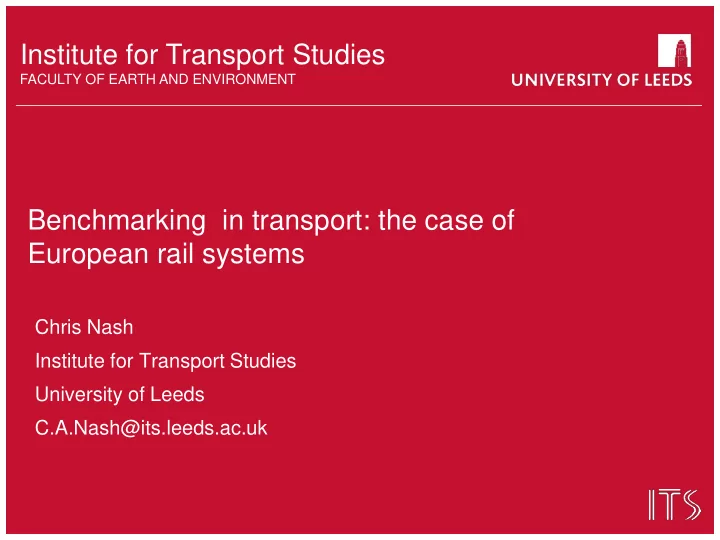

Institute for Transport Studies FACULTY OF EARTH AND ENVIRONMENT Benchmarking in transport: the case of European rail systems Chris Nash Institute for Transport Studies University of Leeds C.A.Nash@its.leeds.ac.uk
Characteristics of railways 1. All European countries have a single national infrastructure manager 2. Competition in the market between train operating companies is confined to commercial services and remains limited esp in passenger services 3. Competition for the market is only used for commercial passenger services in Britain, and is rare for subsidised services except in Britain, Sweden and Germany So benchmarking important esp for infrastructure. For services competition is possible and growing, but still many debates on how best to introduce it
Purposes of benchmarking • May be used to identify efficient costs for regulatory purposes (e.g. Rail Regulator in Britain) • May be used by firms to understand how to become more efficient (e.g. British Rail) • May also aim to inform policy decisions influencing efficiency (e.g. strength and form of regulation, degree of vertical separation, how best to introduce competition for or in the market – e.g. size and length of franchises e.g. Evesrail study specifically on firms of vertical separation
Data Comparability – issues in Evesrail Most authors use data collected and published by UIC but many problems - Varying degrees of subcontracting - New entrants often not members of UIC - Geographical issues – some operators (incl DB and SNCF) pool data for different countries - Definitions e.g. what is a vehicle? - Treatment of subsidies (e.g. for DB assets bought with government grants do not enter the capital value of the firm and are not depreciated in the accounts)
Cost regression: Model • 26 OECD countries – 1994-2010 • Total rail industry cost = f (control variables, test variables) Control variables Test variables (cost drivers not related to policy) (policy variables that may affect costs) Passenger output Vertical separation dummy variable • • Freight output Vertical separation dummy variable * train • • density Route length • Vertical separation dummy variable * freight Technology index • • revenue proportion Wage rate • Holding company dummy variable • Energy price • Holding company dummy variable * train • Materials price • density Capital price • Holding company dummy variable * freight • revenue proportion Horizontal separation dummy variable • Passenger competition measure • Freight competition dummy variable •
Definition of outputs Passenger km and freight tonne km often used. But frequency and degree of crowding important quality variables For freight a train of coal achieves a much higher output in tonne km than a same length train of containers Often, a certain level of train km contractually required. Traffic volumes heavily influenced by geography and policy decisions (relative prices). So train km a better measure (preferably disaggregated e.g. high speed, commuter, regional, container, bulks). Ideally use train km, vehicle km and passenger/freight tonne km.
Exogenous or policy factors • Railways subject to economies of scale (up to some efficient scale) and density • Geography and policy determine length of the network (route km) and heavily influence traffic density Other exogenous factors include inherited quality and capacity of infrastructure (e.g. degree of electrification), climate, length of tunnels and bridges etc Need to introduce control variables to reflect these wherever possible.
Evesrail Cost regression: Summary of key findings • At higher traffic densities, vertical separation increases costs • At mean traffic densities, vertical separation does not significantly change costs • Whereas a holding company model reduces them, compared with complete vertical integration (weakly significant) • A higher share of freight in total revenues increases the costs of vertical separation • Freight traffic may cause more coordination problems in a separated environment than passenger traffic
Conclusions Benchmarking may be useful for - Identifying efficient cost - Understanding how to improve efficiency - Informing policy decisions (e.g. industry structure, nature of regulation, how best to introduce competition, form of franchising etc But studies need careful thought about model specification and are demanding in terms of data requirements In practice, models can never be precise, but provide important evidence.
Recommend
More recommend